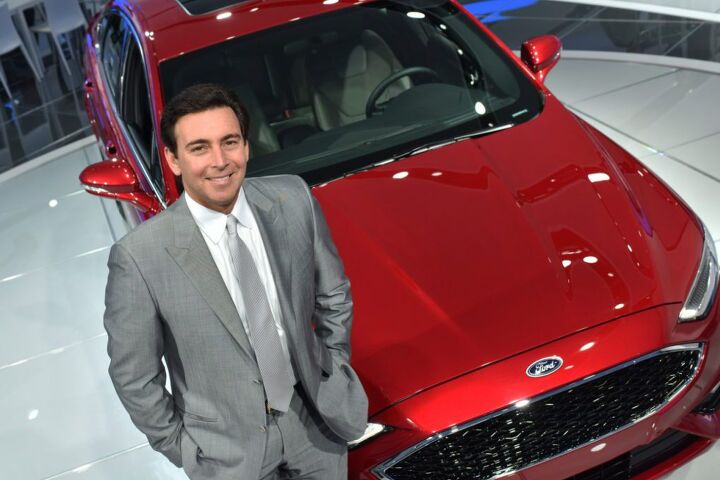#Streamlining
Hackett's Axe Falls in Earnest As Ford Announces 7,000 Salaried Cuts
The steep white-collar job cuts that simmered on Ford’s back burner for a year have come into clear focus. In a letter to employees on Monday, CEO Jim Hackett announced the elimination of 7,000 salaried positions — some 10 percent of the automaker’s global workforce.
The move, part of Ford’s $11 billion restructuring plan, also calls for a 20-percent reduction in the company’s upper tier management. In the U.S., much of the pain will start being felt this week.
This Is the Year, Ford CEO Tells Employees
Of all the Big Three domestic automakers, Ford’s direction seems the most ambitious and confusing. Since taking the helm less than two years ago, CEO Jim Hackett has tried to articulate his vision for both the company and the country’s future roads, sometimes with head-scratching results.
There’s no doubt that change is afoot. The company has already ceased production of all but one of its non-Mustang passenger cars and taken the first steps to getting its lagging overseas operations in order. But 2019 is the pivotal year, Hackett said in a memo to employees. For the sake of Hackett’s future, it had better be.
GM Begins Axing 4,000 Salaried Workers
Last Friday’s whisperings of a “Black Monday” panned out, with General Motors announcing the elimination of roughly 4,000 salaried workers — part of a preexisting pledge to reduce its North American workforce by 15 percent.
Pink slips are in the process of being handed out, an unwanted delivery that should take two weeks to complete. In total, GM hopes to cull 8,000 salaried workers and reduce its executive ranks by 25 percent.
Freeing Up Factories: Toyota to Consolidate Electronics Operations Within Denso
Toyota Motor Corp. says it had reached an agreement to consolidate all of its core electronics component operations within Denso. The move should allow Toyota to free up resources to compete more effectively in the new vehicle technology field.
Japan’s largest automaker noted it still has to discuss the logistics of transferring production of parts produced at its Hirose plant, near Toyota’s global headquarters, before the end of next year. But Denso, the company’s largest supplier, has already agreed to the core concept of the deal. By 2022, Denso will have taken over the mass production of all electronics components used in Toyota’s vehicles.
Ford Plans Salaried Position Cull in North America, Asia
A day after media reports described an impending mass layoff of Ford Motor Company employees, the automaker has clarified who gets to keep a job.
While the scale of the job reductions is less than previously reported — a 10-percent global workforce reduction is off the table — Ford does plan to cull its salaried North American and Asian workforce by one-tenth in a bid to cut costs.
The move comes after last week’s tense shareholders meeting during which investors and analysts grilled CEO Mark Fields over the company’s sinking market valuation. Since taking the helm three years ago, Fields has seen the company’s stock price sink by roughly 40 percent. Hourly workers aren’t affected by the plan, though the same can’t be said for white-collar employees.
Volkswagen Finds a Way to Dump Huge Numbers of Employees and Keep the Union Happy
Volkswagen’s plan to cut costs by cancelling underperforming models isn’t enough to right the scandal-rocked ship.
With an incredibly powerful workers union breathing down its neck, trimming its ranks has proved a tough operation. Meanwhile, there’s only so many models it can drop, and bills are coming due from the many fines, settlements, and lawsuits stemming from the diesel debacle.
How does Volkswagen get rid of 25,000 employees while placating a union boss who sits on the supervisory board?
According to Reuters, the answer comes down to one word: attrition. Specifically, retiring Baby Boomers.
Do Today's Cars All Look Alike?
An Illustrated History Of Automotive Aerodynamics – Part 3: Finale
[Note: A significantly expanded and updated version of this article is here]
For most of the fifties, sixties and into the early seventies, automotive aerodynamicists were mostly non-existent, or hiding in their wind tunnels. The original promise and enthusiasm of aerodynamics was discarded as just another style fad, and gave way to less functional styling gimmicks tacked unto ever larger bricks. But the energy crisis of 1974 suddenly put the lost science in the spotlight again. And although historic low oil prices temporarily put them on the back burner, as boxy SUVs crashed through the air, it appears safe to say that the slippery science has finally found its place in the forefront of automotive design.
An Illustrated History Of Automotive Aerodynamics – In Three Parts
[Note: A significantly expanded and updated version of this article can be found here]
That air presented the greatest obstacle to automotive speed and economy was understood intuitively, if not scientifically since the dawn of the automobile. Putting it into practice was quite another story. Engineers, racers and entrepreneurs were lured by the potential for the profound gains aerodynamics offered. The efforts to do so yielded some of the more remarkable cars ever made, even if they challenged the aesthetic assumptions of their times. We’ve finally arrived at the place where a highly aerodynamic car like the Prius is mainstream. But getting there was not without turbulence.
Lincoln: A Brief History Up To 1961
In honor of our greatest president’s birthday this Friday, it’s going to be Lincoln Week at Curbside Classic. We’ll start with a brief history of the brand to set us up for the sixties, when our featured cars begin.

























Recent Comments